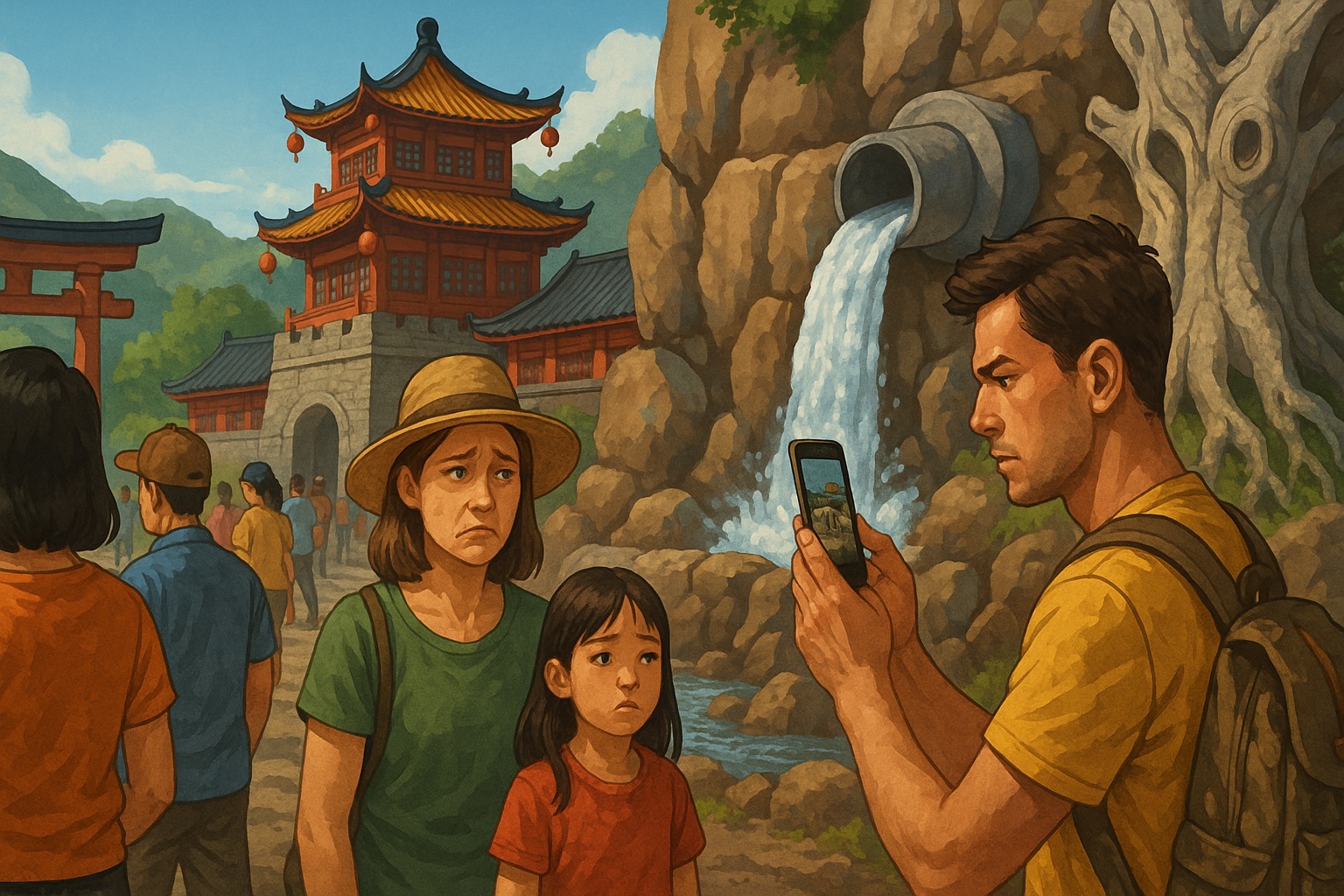Beneath the Surface: China's Hollow Tourism Boom

In recent years, a deluge of reports and viral videos has exposed a troubling trend across China’s tourism sector: the construction of fake scenic spots deceptively marketed as ancient marvels or natural wonders. From cement “ancient” trees to staged waterfalls and knock-off international villages, the illusion is beginning to crackand what lies beneath is a commentary on economic ambition, governmental complicity, and the manipulation of cultural narrative for profit.
At first glance, these destinations promise authenticity, history, and natural beauty. But visitors soon discover a fabricated reality. A vlogger’s widely circulated video reveals “ancient” trees clearly sculpted from cement, and “stalactites” inside supposedly natural caves that are nothing more than burlap-and-cement constructions. Scenic areas, once thought to be awe-inspiring, unravel into elaborate sets not far removed from theme park gimmicks. The illusion is not only misleading but also expensive, both financially and culturally.
Take the example of Hunan's Yunai Mountain. Marketed as a captivating natural waterfall retreat, its visual appeal disintegrated the moment tourists spotted the industrial water pipe discreetly feeding the cascade. Elsewhere, disaster has struck outright. In June 2025, a building at the Taishan Museum Scenic Area in Shanxi collapsed into rubble. The local Cultural Heritage Bureau's flippant response, “These buildings aren't cultural relics, so don't worry”underscored an official indifference that sparked public outrage. The incident served as a wake-up call, revealing that many such structures had never possessed historical value to begin with.
This ongoing deception, in many ways, reflects a larger systemic issue rooted in China’s approach to cultural tourism. The Chinese government, in its quest to boost local economies and meet performance quotas, has often partnered with developers to construct massive “ancient towns” from scratch. These synthetic heritage sites, built with billions in public and private funds, are designed more for visual consumption than cultural preservation. They spring up quickly, grand opening ceremonies often accompanied by glittering advertisements, celebrity endorsements, and high hopes. Yet within a few short years, many of these towns lie abandoned, with weeds reclaiming unfinished structures and ticket booths gathering dust.
Consider Jang Jaji’s Dong Ancient City, a project that swallowed 2.5 billion Yuan (roughly $348 million). Today, it exists mostly as a glorified parking lot, parking fees bring in more revenue than tourist visits. Songfung Ancient City, spanning over 100 acres, remains unfinished even after five years, its partially built skeleton left to rot beneath overgrown fields. These ghost towns, now synonymous with failed investment, aren’t isolated misfortunes. They're part of a national trend. Of the 23,000 newly constructed themed attractions across China, fewer than a quarter survive beyond their third anniversary. The rest fall victim to disinterest, mismanagement, and disillusionment.
The deeper issue stems from how these projects are conceived: performance-driven local governments borrow extensively to finance large-scale attractions, obsessed with prestige and political metrics rather than long-term viability. In their push to impress central authorities or attract temporary investor interest, sustainability and historical authenticity are relegated to after thoughts. Ancient towns should serve as vessels of memory, echoing the legacy of past generations, not hollow vanity projects or monetization tools for a fleeting tourist selfie.
What exacerbates this situation is the internet-fuelled spectacle of "check-in" culture. Influencers, sometimes in league with local governments or tourism operators, curate idyllic images of these destinations using strategic angles and heavy filters. And the result? Thousands of tourists misled by Photo-shopped landscapes and artfully staged promotional videos. One example includes the infamous "rooftop relaxation" photo spot in Liyang. The camera suggests serenity, cultural immersion, and picturesque charm. Reality? A dingy, garbage-strewn environment that charges 60 yuan just to stand near a prop.
This digital bait-and-switch strategy fuels false expectations and deepens consumer distrust. Guo’s Chi Jang "Thousand Households Meow Village" is another case in point. Promoted as a magical locale populated by glamorous women in traditional garb, it lured travellers from across the country only for them to arrive and find aging locals and empty streets.
And the mimicry doesn’t stop at national faux heritage. Across China, budget knockoffs of global destinations are spreading like wildfire. “Little Kyoto,” “Mini Switzerland,” “Pocket Santorini”,,these themed replicas number in the dozens. According to incomplete statistics, there are 43 “Little Santorinis,” 102 “Kyotos,” and even 40 “Little Naras.” To craft a “Japanese-style town,” it seems all that’s required is a winding path, a few shrubs, and a pair of torii gates. International charm becomes a costume for spectacle, empty of substance and often poorly executed.
Ultimately, tourists foot the bill. They spend precious time and money chasing illusions, only to be met with disappointment, misleading setups, and inflated prices. As one blogger gravely warned, even the souvenirs gemstones, silver bowls, or decorative ingots are often fakes.
This pervasive culture of deception calls for deeper scrutiny. It reveals not only the exploitation of cultural symbols for financial gain but also how top-down governance can prioritize short-term metrics over meaningful preservation. Until local governments, developers, and promoters realign their incentives with genuine cultural integrity, these attractions will remain little more than mirages in concrete and paint charming from afar, hollow up close.




![From Kathmandu to the World: How Excel Students Are Winning Big [Admission Open]](https://nepalaaja.com/img/70194/medium/excel-college-info-eng-nep-2342.jpg)
